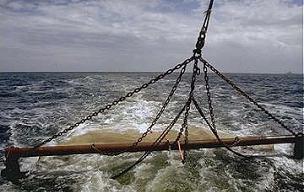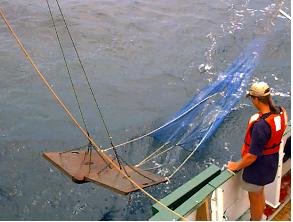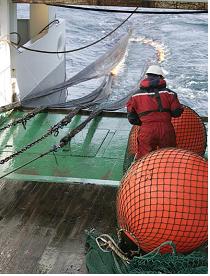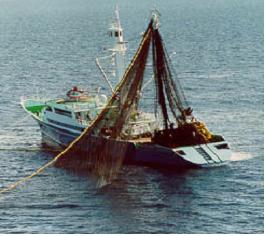|
Active Gears
Active fishing methods are especially suitable for sampling large proportions of
the whole fish stock or large numbers of fish. The term “active” means
that the fishing gear is dragged through the water by human, animal or engine power.
In most cases the efficiency of active gear is considerably higher than that of
“passive” gear, such as gillnets and traps, which rely for their efficiency
on the movement of the fish themselves.
Beam trawl

Beam trawl
In this type of trawl, the mouth or opening of the net is kept open by a beam, which
is mounted at each end on guides or skids, which travel along the seabed. The trawls
are adapted and made more effective by attaching tickler chains (for sand or mud)
or heavy chain matting (for rough, rocky ground) depending on the type of ground
being fished. These drags along the seabed in front of the net, disturbing the fish
in the path of the trawl, cause them to rise from the seabed into the oncoming net.
Modern beam trawls range in size from 4 to 12 m (weighing up to 7.5 tonnes in air)
beam length, depending on the size and power of the operating vessel.
Demersal otter trawl

Bottom trawl
The demersal or bottom trawl is a large, usually cone-shaped net, which is towed
across the seabed. The forward part of the net – the ‘wings' –
is kept open laterally by otter boards or doors. Fish are herded between the boards
and along the spreader wires or sweeps, into the mouth of the trawl where they swim
until exhausted. They then drift back through the funnel of the net, along the extension
or lengthening piece and into the cod-end, where they are retained.
The selectivity of trawl fisheries may be increased by the use of devices known
as separator trawls. Separator trawls exploit behavioural differences between fish
species and can be used, for example, to segregate cod and plaice into the lower
compartment of the net, whilst haddock are taken in the upper part. The mesh size
for the two compartments can be altered according to the size of the adult fish
being targeted. Insertion of square mesh panels also improves selectivity of the
net because square meshes, unlike the traditional diamond shape meshes, do not close
when the net is towed. Sorting grids are compulsorily fitted in nets in some prawn
and shrimp fisheries to reduce bycatch of unwanted or non-target species, including
small prawns and shrimp.
Depending on the depth of water fished and the way in which the gear is constructed
and rigged, trawling may be used to catch different species. Trawls can be towed
by one vessel using otter boards, as in bottom-trawling, or by two vessels, each
towing one warp, as in pair-trawling or more than one trawl can be towed simultaneously
as in multi-rig trawling.
Pelagic trawl

Pelagic trawl
When trawling takes place in the water column or in mid-water between the seabed
and the surface, it is referred to as mid-water or pelagic trawling. Pelagic trawls
target fish swimming, usually in shoals, in the water column i.e. pelagic species.
These include seabass, mackerel, Alaska pollack, redfish, herring and pilchards
for example. Their effectiveness relies on traversing a considerable volume of water,
and consequently nets are larger than bottom trawls and require a large vertical
and horizontal mouth opening to provide net stability and capture large shoals of
fish.
The length of time the net is towed through the water is shorter than in bottom
trawling in order to capture the shoals of fish the net passes through. To handle
the large amounts of fish, pumps are used to transfer the catch from the cod-end
to the boat.
In mid-water pair trawling the otter boards are replaced, and the mouth of the net
kept open, by a pair of trawlers. This enables vast nets, often ¼ mile wide
and ½ mile long, to be towed through the water column to capture the fish.
Seine netting

Seining
This is a bottom fishing method and is of particular importance in the harvesting
of demersal or ground fish including cod, haddock and hake and flat-fish species
such as plaice and flounder. The fish are surrounded by warps (rope) laid out on
the seabed with a trawl shaped net at mid-length. As the warps are hauled in, the
fish are herded into the path of the net and caught. Effectiveness is increased
on soft sediment by the sand or mud cloud resulting from the warps' movement across
the seabed. This method of fishing is less fuel-intensive than trawling and produces
a high quality catch, as the fish are not bumped along the bottom as with trawling.
Purse seining
This is the general name given to the method of encircling a school of fish with
a large wall of net. The net is then drawn together underneath the fish (pursed)
so that they are completely surrounded. It is one of the most aggressive methods
of fishing and aims to capture large, dense shoals of mobile fish such as tuna,
mackerel and herring.
Trolling

Trolling
Trolling involves towing baited hooks or lures through the water. The method is
particularly suited to the capture of pelagic species of high individual value.
Examples include tuna (albacore and skipjack), barracuda and salmon.
Harpoon
Harpoon
This method is used for fish having high individual value such as swordfish and
bluefin tuna. Harpooning is a completely selective fishery, since the target must
be seen before striking, so the size and hence age can be determined and only mature
fish taken.
Top
|